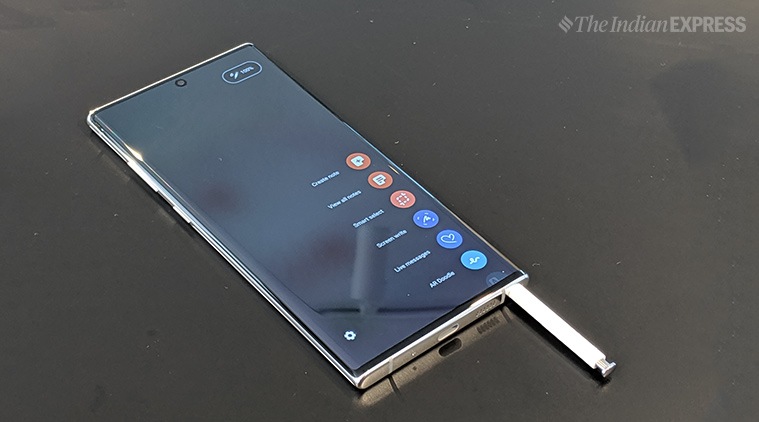
Imagine being able to open the camera app on a smartphone with a stylus like a wand, or scrolling through photos by flicking your hand left and right in the air without touching your phone. This may seem like science fiction, but it can now be possible with the Galaxy Note 10 which is bringing back the “touchless gesture control” feature to the mainstream smartphone market in a big way.
“There was this need, I don’t need to touch my phone to be able to enjoy it. I personally have struggled with it, the front-facing camera never got a perfect shot. But If I can place it somewhere, and from a distance, I can manage the zoom in and out…I can manage the front and back camera without touching the phone,” Ranjivjit Singh, SVP and Chief Marketing Officer, Samsung India, tells indianexpress.com in an interview on the sidelines of the launch of Galaxy Note 10 in India.
With Air Actions, a Galaxy Note 10 user will be able to use the S Pen stylus to switch between selfie and video modes. You will also able to make circular motions in the air with the S Pen to zoom in and zoom out. And that’s not all, it’s also possible to take a picture by pressing the button on the S Pen. Like Singh said, this can be useful if someone wants to take a selfie from further way.
Singh agrees that touchless gesture controls will be a big part of smartphones in the future and “Air Actions” is just the beginning. In fact, the company is so serious about touchless gesture controls that it has created Air Actions SDK so that developers can take advantage of these gestures in third-party apps.
Also read| Samsung Galaxy Note 10+ hands-on: This premium flagship feels just right
The idea of controlling a smartphone from a distance without contacting the touchscreen has always attracted smartphone makers. Many don’t remember this, Samsung was one of the first few smartphone players to introduce touchless gesture controls on phones way back in 2013. Its Galaxy S4 had Air Gestures which allowed users to interact with the screen without actually touching it. By hovering your fingers on the screen, you could control page scrolling with a vertical swipe, or accept calls by waving your hand over the phone. The big issue with touchless gesture controls on the Galaxy S4 was that they felt gimmicky and more importantly, less accurate.

However, the long-forgotten feature is making a comeback with the Galaxy Note 10. This time, though, Samsung appears to be more confident in its efforts to bring touchless gesture controls to smartphones. It is betting on the trusty S Pen to perform air gestures, such as changing camera modes with a wave of your hand.
Also read|Galaxy Note 10 is Samsung’s secret weapon to disrupt the premium smartphone market
But Samsung isn’t the only company that made a strong bet on touchless gesture controls on smartphones as the next big thing. Google and LG are also looking at this trend closely, though they have different solutions to bring air gestures on mobile devices. Google’s upcoming Pixel 4 has a feature called Motion Sense that allows users to skip songs, snooze alarms and silence phone alarms, just by waving your hands. The new Motion Sense feature is powered by Google’s years of work on Project Soli, a motion-sensing radar. The Pixel 4 is expected to launch later this year.
LG, too, offers air gestures on its flagship G8 ThinQ. A front-facing Time-of-flight (ToF) sensor, called the Z Camera, reads motion in front of the device. This sensor essentially enables air gesture capabilities on the G8 ThinQ, like controlling music playback, dismissing calls, capture screenshots and so on.
Also read| Samsung Galaxy Note 10 vs Note10+: 9 features that make them different
While companies like Samsung and Google may tend to believe that the world is ready for gestures on phones, one thing to keep in mind that the use case of touchless gestures is fairly limited at the moment. Even if these gestures work as advertised, they have to offer at least one or two transformative feature that consumers don’t know they wanted. The question of accuracy, as well as the distance that requires our hand to be away from the phone’s screen, also comes into play.
William Stofega, an analyst with IDC, says touchless gestures could be a big thing in the smartphone space in the future. “Just moving away from one single input, right back in the day, whether it was just speech or whatever. So, speech is something that is very, very important and very popular, but you may not always want to do a speech,” he adds.
Stofeaga points out that touchless gestures can be one of the ways of inputting and controlling the device, other than speech. However, he also added that it will take some time for people to get used to air gestures and learn how to use it properly.
Disclaimer: The author is in Bengaluru attending the Galaxy Note 10 launch on the invite of Samsung India